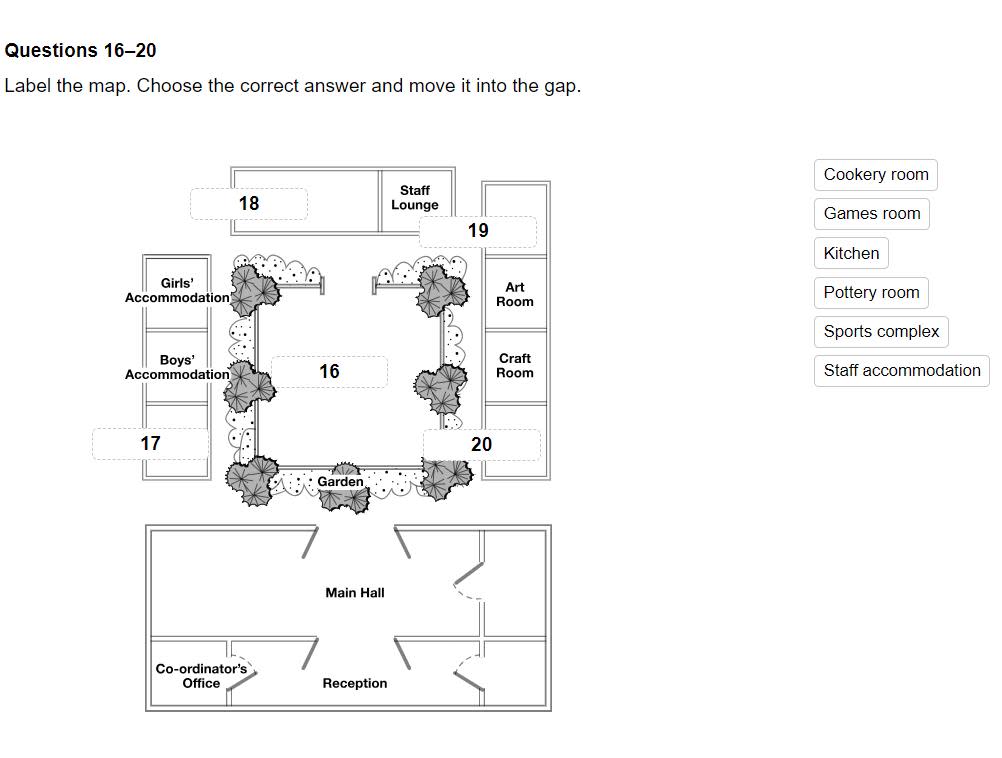Summary: Learn how to tackle IELTS Listening map labelling tasks with clear strategies, examples, and preparation tips to improve your test performance.
How can you master IELTS Listening map labelling questions effectively?
In the IELTS Listening test, you may be asked to label a map. This is a common task type for Section 2, so it’s worth having a look at how to tackle this kind of question.
Get a dream preparation pack for IELTS!
Access 70+ free IELTS mock tests, a lifetime prep bundle, expert sessions, study plan and more.
IELTS Listening map – Task types
There are two types of map labelling questions that you can receive in the IELTS Listening test.
One type is where the items on the map are blank and you must use words directly from the recording, while the other type is where you can select options from a list (e.g. A – G). The maps can be of an outdoor space or inside a building.

Sample map labelling question with list of options to select
Source: IELTS Listening on computer familiarisation test
IELTS Listening map - Approach
To help with labelling an IELTS Listening map, it is a good idea to use your preparation time well. Here are a few things to consider:
1. Make sure you know the starting point the speaker uses.
Sometimes the speaker will say where they are standing and which direction they are looking, so this is an important step. When giving directions, the speaker may return to this starting point for the subsequent questions, not just the first one.
2. Look at the shapes of items.
The speaker may describe items in the diagram with adjectives and nouns (e.g. circular / circle, curved / curve).
3. Look at what the question number is connected to on the map.
You can do this by paying attention to words related to location. These words can be prepositions (e.g. across from / next to / behind / below / near / under / etc.) as this type of word is often used for directions.
Quite often, there are two items that have some similarities. For example, they could both be on the same side of a street, but one of them is before the intersection and the other one is after it. The incorrect option in this choice is called a ‘distractor’ and these are used to test your understanding.
4. Be aware of the compass rose
Look at the compass rose if it is used (not all maps will have one of these). A compass rose is a round design with pointed lines showing the directions north - south etc. Listening to compass directions can help you pinpoint the item that the speaker is referring to, such as ‘in the north-east’ or ‘to the south of’.
If there is no compass rose, then the speaker may use words related to left and right, such as ‘to the left of’ or ‘on the right-hand side of’.
5. Make sure you use the right number of words for your answer.
When it comes to the question type where you have to write what the speaker says, make sure you do not exceed the word limit, so take note of this early on.
Preparation tips for IELTS Listening map labelling
To become more confident at labelling a map, try these IELTS Listening preparation tips:
Get used to listening to directions in different contexts.
Draw your own map and give directions to someone else and see if they can follow where you are telling them to go.
Have a look at the transcript of what the speaker says when you do IELTS test practice. Take note of the signposting words and language related to directions and positions. See why some of the other options are incorrect too.
IELTS Listening Map Practice
Another good way to improve your skills in this area is with a practice task. To practice labelling a map and other parts of the Listening test, try our IELTS Listening practice questions.
For more expert advice on IELTS Listening, visit our IELTS Preparation Hub.
IELTS Listening: FAQs
Find answers to frequently asked questions about IELTS Listening.
What types of questions will be asked in the IELTS Listening test?
You will be asked to complete a range of question types in your IELTS Listening test. These will include some of the following: multiple-choice, matching, labelling a map/plan/diagram, sentence completion, note completion, form completion, table completion, flow-chart completion, summary completion and short-answer questions.
What kinds of accents will I hear in the IELTS Listening test?
You’ll hear a range of different accents in the IELTS Listening test such as British, Australian, New Zealand and North American.
Is it possible to retake just the Listening section of the IELTS test?
IELTS One Skill Retake allows you to retake one section of the test again. If you didn’t get the IELTS Listening score you were hoping for, you can take this section of the test again if you have completed a full IELTS test at a centre that offers One Skill Retake, your full test was an eligible IELTS on Computer test and you take your One Skill Retake within 60 days of your full IELTS test.